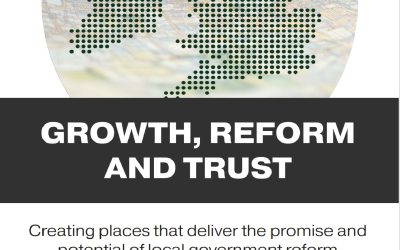By Wallace Sampson OBE, former Chief Executive, Harrogate Borough Council
A persistent failing of the local government sector is its historic and current lack of inclusion and representation of ethnic minorities at all levels. The data currently available shows that council workforces under-represent minorities in all regions across England and Wales, and it is likely that representation in senior leadership positions is worse still. This is a fundamental flaw in a sector which purports to closely represent and speak for our communities and respond to their needs. The challenges faced by ethnic minorities climbing the ladder to senior leadership is illuminated by Wallace Sampson, former chief executive of Harrogate Borough Council, who shares personal experiences of race-based discrimination in the recruitment process. Unfortunately, Wallace’s story portrays a sector which has not changed quickly enough over the last fifty years in this respect. Indeed, Solace’s 2023 report on Equality, Diversity and Inclusion across the sector describes a disappointing record of data collection on representation, which must improve if councils are to make progress on this incredibly important issue.
The highs and lows of a life in local government
As Solace reflects on fifty years serving local government and the wider public sector, it gives me an opportunity to also reflect on my own forty years public service.
I have so many wonderful memories to look back on and undoubtedly the highs considerably outweigh the lows. My early career coincided with a significant period of change in local government taxation as we moved from general rates to community charge (poll tax) and council tax in a very short period of time. I still have a vivid recollection of recording rating transactions in a huge ledger, and sometimes calculating voids, reliefs and occupations manually. The transition to new systems of taxation required great change and the introduction of new technology, so it was an exciting time for people like me who thrive on transformation.
I was fortunate throughout my career to work for councils who believed in my ability to deliver, and I can look back on many successes with a strong focus on service improvement, the customer and communities. I was privileged to work with staff, partners and teams that delivered award[1]winning outcomes and provided legacy benefits. Without a doubt, however, one of my proudest moments was Harrogate hosting the finish of the Grand Depart of the Tour de France in 2014. It is one of Yorkshire’s proud moments and Harrogate was very much at the heart of the occasion, with hundreds of thousands of visitors to the region and millions watching worldwide.
Much has changed since I entered local government in 1983, but undoubtedly the last 15 years has been the toughest of them all. Local government has borne the brunt of austerity more so than other parts of the public sector, and we now have to do so much more with so little. As I step back from the day-to-day challenges of being at the helm of a local authority, it is with the knowledge that the system is now at breaking point and the future sustainability of some councils is a realistic prospect.
A source of shame
However, one issue which has changed little over the past forty years, is how few chief executives, or even senior leaders more generally, there are of colour in public service compared to the demographics of our society. A survey was undertaken in 2018 by Green Park that estimated that there were 16 persons of colour in chief executive roles in local government. Despite some changes in the last five or six years, my guess is that the changes are not seismic.
The statistics clearly do not match the demographics of our society. According to the 2021 Census data 18% of people in England and Wales belong to a black, Asian, mixed or other ethnic group. Reflecting society would mean that there should be about 58 people of colour leading the 320 or so local authorities across England and Wales. That would really be a seismic shift.
My earliest recollections of persons of colour at chief executive level in local government are (Lord) Herman Ouseley and Gurbux Singh, and they were followed by others that I recall such as Heather Rabbatts and Darra Singh. All have had the level of profile and success that should have opened the gates for many others to follow, but it hasn’t happened and we should ask why.
A good friend of mine undertook research as part of his doctoral thesis into why there were so few people from a BAME background in leadership positions in local government and the NHS. In his thesis he emphasises the importance of “gatekeepers” – the people who are in a position to select and appoint senior executives. He argued that these gatekeepers need to question their true levels of commitment to achieving greater levels of diversity.
Battling bias
Perhaps my own experiences can offer some further insight.
Until recently I was the chief executive of Harrogate Borough Council in North Yorkshire. I served in that role for almost 15 years and for a lot of that time I was the only local authority chief executive from a BAME background in the whole of Yorkshire and the Humber, a region which covers a population of 5m people. To my knowledge during that 15-year period there was one person of colour in the North East briefly in a chief executive position, and there were none in the North West.
Notwithstanding my appointment at Harrogate, it has been a mixed picture to get to where I am. In some respects, being black has shone a spotlight on me, but my perception has been that sometimes I have had to work harder to prove myself because I am black.
On at least one occasion I believe there was bias in the process because of my colour. I recall vividly how I felt after one council said that a degree equivalent qualification was not enough in a chief executive recruitment process, even though it wasn’t stated that ‘degree equivalent’ would be ineligible. I have always been honest with myself in recruitment processes. There have been occasions when I have not performed well enough and I am the first to acknowledge it. There have been other occasions when I know that I have performed well but not been appointed to the post. I have never had a problem with that because I understand that sometimes there will be the simple reason of not being the right ‘fit’ for the organisation. However, to fail to reach a shortlist because you only have a degree equivalent qualification, an ineligibility which is only introduced once the process has started, is much harder to understand. I met all of the other criteria and it was such a minor reason to not shortlist me, that it is hard not to conclude that colour played a part in the decision, at least with the senior decision makers knowing as I do the demographics of that particular area.
On another occasion I was in a long list interview process with a recruitment consultant and technical assessor. Part way through the interview the technical assessor asked me why X, who is a high profile former chief executive, thought so highly of me. I have only met X once and it immediately struck me as a case of mistaken identity, and to make matters worse I know the person that the technical assessor believed I was. Again, I am honest enough with myself to acknowledge that my performance in that interview did not merit moving from longlist to shortlist. What disappointed me was that I was mistaken for another black person bearing in mind that there are so few of us in local government. Do we all look the same?
For those without the mental toughness and resilience that I possess it would have been a very difficult situation to be faced with. You consider whether you should challenge and if so, how does it affect your future prospects in an environment where recruitment consultants are very powerful in the search and selection process. Or alternatively you dust yourself down and go again. There is no right and wrong in how you should approach this but situations such as this shouldn’t happen in the first place.
How to drive diversity
So, if we are to move towards a more diverse and inclusive workforce where the demographics of our senior leaders reflect society, how can we better support people of colour in their career progression in local government? I would suggest four things from my own personal experience, although I accept that the views of others may differ.
Firstly, without a doubt the sector has to showcase successful people of colour as role models more than we currently do. We can go further and establish specific buddying and mentor programmes for aspiring black leaders to be supported by successful leaders from the BAME community. Success breeds success and emerging leaders will gain confidence and learn from being closely associated with people that they can more easily identify with.
Secondly, we need to have a more targeted approach to spotting and nurturing emerging talent from the BAME community at the earliest opportunity. I am aware that Solace is working jointly with the Local Government Association to create a broad programme of activity around leadership and development as part of its sector support offer to local authorities. It will certainly assist the sector as a whole but, Solace’s AMPlify programme aside, very little is specifically targeted at talented rising stars from under-represented groups. Perhaps, for example, there should be targets within the National Graduate Development Programme to ensure that the cohorts from each intake reflect the diversity of our community.
Thirdly, there should be short-term placement opportunities created for aspiring leaders to be placed as heads of services and directors as development opportunities. It will be challenging to establish, but it is possible to do. The NHS has an Insight programme for placing people from diverse backgrounds into Non-Executive Director roles for a period of nine months to help their development. Many NHS Trusts have joined the programme and I know of individuals from the BAME community that have benefitted from the Insight programme.
And finally, we need to work with the decision makers, particularly councillors, because not enough emphasis is placed on diversity issues in recruitment training for those that are the final decision makers and gatekeepers for the most senior roles in local government.
The attributes that make a good leader
To conclude this essay, I wanted to share my thoughts about being a leader, because leadership is tough in any environment, regardless of colour, and especially challenging in local government today. In my experience there are essential attributes that differentiate good leaders from others. Other leaders may have a different perspective so these are certainly my own personal reflections. Firstly, it certainly helps to have the ability to articulate a vision for the organisation and a clear strategic direction. This needs to be aligned with good communication skills so that the whole organisation understands where you are going and how you will get there. Not everyone will buy in, but they do need to understand.
Secondly, good leaders are also visible and not remote, and can move comfortably from coal face to the boardroom. Technology advances now mean that you can be visible to the whole organisation, so it isn’t always about being seen ‘in person’.
Thirdly, the values and behaviours of the organisation must be owned and embraced from the top every single day. Don’t expect others to behave in a way that you are unwilling to.
And finally, resilience is so important in the modern environment of constant pressures – if you are not durable you won’t last in the role. It’s important to find your own ways of ensuring your resilience. Mine was through exercise and sport as well as having a strong buddying network. I have a chief executive colleague who I have been close friends with for almost 25 years, and we have created an environment of mutual support and trust. I would definitely advise building networks of like-minded peers that will support, challenge, and inspire you.
Not everyone is suited to leadership but looking ahead the sector is going to need strong and resilient leaders who get a buzz from the ability to influence change and make things happen. It isn’t easy to reach the top but it is even harder to stay there. It is such a challenging landscape that the best leaders will thrive on the responsibility and accountability, with a sound understanding of the critical relationships required to succeed in their environment.
There are so many amazing people working in local government with great leaders at the helm that I am optimistic about the future. I hope that the sector continues to deliver on its commitment to equality, diversity and inclusion, so that Solace can celebrate in the next 50 years a leadership profile that truly reflects the diverse society of our nation.
- This is essay is part of a collection of articles by former chief executives looking back at their careers published by Solace as part of its 50th birthday celebrations. You can read the full Rewind: 50 years of local government excellence collection here.






